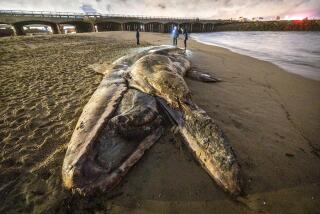Marine predators rebounded after worst extinction on Earth, study says
When a major extinction takes place, apex predators — those giant beasts sitting at the top of the food web — are often the first to suffer. But it turns out that in the worst extinction event in Earth’s history, they might have actually branched out a little, according to a new study in PLoS ONE that looked at ancient armored amphibians and giant swimming reptiles.
While the asteroid that wiped out the dinosaurs some 66 million years ago was a violent and dramatic end, this end-Cretaceous event wasn’t the worst extinction in Earth’s history. That dubious honor goes to the end-Permian event 252 million years ago, which wiped out nearly 90%t of all life in water and close to three-quarters of life on land.
In such major extinctions, large, apex predators don’t seem to weather drastic changes as well as other animals. Perhaps that’s in part because they’re often slow to reproduce, or that they need a large area filled with other edible animals in which to hunt. Environmental disasters work against them on both fronts.
“By occupying the top of the food webs, apex predators are highly susceptible to environmental fluctuations and stress,” the study authors wrote, “and, therefore, they are key for understanding ecosystem recovery after extinction events.”
Apex predators play an important role in controlling populations of species lower in the food web. By preying on the sick and weak, they put selection pressure on the species they hunt and thus help keep the populations healthy. So understanding how those ancient predators reacted in a changing environment can tell us a lot more about the shape of that ecosystem.
To find out how these large carnivores really did during the catastrophic end-Permian, an international team of researchers analyzed the distribution of vertebrate marine carnivores and their body sizes. Scientists had long figured it had taken large predators a long time — 8 million to 9 million years — to recover from this extinction, as the old guard were wiped out and new species grew in size to eventually take their place at the top of the chain.
Instead, they found that a whole range of apex predators recovered very quickly after the end-Permian. Giant fish ruled the seas along with crocodile-like amphibians called trematosauroids and the strange, shark-like Eugeneodontida, a cartilaginous fish with a weird, round whorl of teeth protruding from its lower jaw.
While the extinction didn’t seem to affect the structure of the food web near the top, it certainly seemed to shuffle around the key players. This particular reordering didn’t last too long, however. Two million years later, another extinction event took place: While fish remained, the ancient amphibians gave way and reptiles took top spots in the oceans. One such mega reptile, Askeptosaurus, could have stretched 13 feet in length.
ALSO:
Scientist finds 19 new species of praying mantis
This robot fish with sea-green skin swims like the real deal
Nanuqsaurus: This pygmy Tyrannosaur prowled the ancient Arctic







